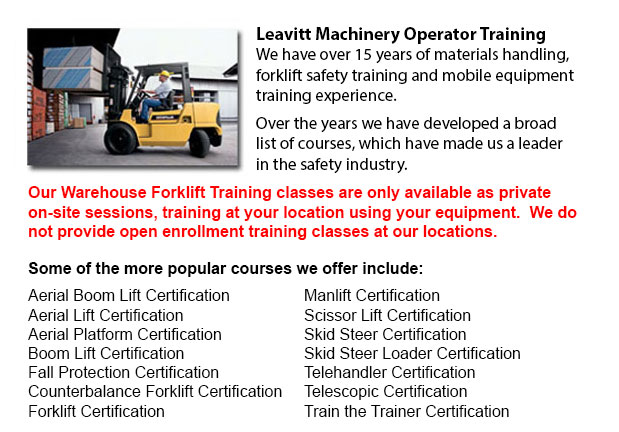
Oshawa Warehouse Forklift Safety Training - The corporation would face claims for liability when injuries and damage are sustained in an accident at the workplace. Warehouses could be a dangerous place to work for its workers, making employee safety a top priority for the company. Warehouse safety training is one of the most effective methods to protect employees, while minimizing costs associated with accidents and injuries.
The warehouse holds large amounts of stock and materials that can pose dangers, particularly when these are being moved. The moving of stock utilizing a powered equipment or manually can lead to injuries the workers' hands, fingers, toes and feet. Slipping, tripping and falling are common reasons for injury. Heavy things can fall off shelves and harm employees. Forklifts and other machinery carry inherent hazards because they manipulate heavily laden pallets. Incorrect lifting is a common source of back injuries. Even box cutters, nails and splinters could result in harm.
Warehouse conditions can change from one minute to the next, depending on the materials or substances being handling, the job being carried out and the machine being used. Because of the wide variety of potential hazards in warehouse settings, warehouse operations are regulated by many different standards. There are rules for storage and material handling, for walking and working surfaces, and regulations governing the use and selection of PPE (personal protective equipment).
A lot of warehouse safety rules are common sense. Here are a number of examples of warehouse regulations all staff should be familiar with:
1. Safety is a top priority at all times while working in a warehouse.
2. PPE, like for example gloves, safety shoes, hard hats and eye protection, should be worn as appropriate.
3. Check for hazards and report them or correct them.
4. Know warning signals and signs - and follow them.
5. Pay attention to the job you are doing.
6. Pay attention to what others are doing nearby - especially forklifts and various dangerous machinery.
7. Make sure that stacked products and materials are stable and secured.
So as to guarantee a safe warehouse, personnel must follow good housekeeping rules. Essential regulations for housekeeping involves keeping the floors and aisles clear of items such as cords and wires. Never perch items insecurely on a surface. When spills take place, clean up immediately. Throw trash in correct containers. Keep sprinklers, fire exits and fire extinguishers accessible. Put box cutters and various sharp tools away instantly after use. Report tripping hazards like for instance damaged or loose flooring.
-
Oshawa Scissor Lift Operator Certification
Oshawa Scissor Lift Operator Certification - North American regulators recommend that worksites need operators of scissor lifts, booms or aerial work platforms to obtain certification training. Scissor lift operator certification is not mandatory, bu... More -
Narrow Aisle Forklift / Order Picker Training / Electric Pallet Jack / Electric Pallet Truck Training in Oshawa
A pallet lift is a model of equipment dedicated in the moving of pallets of many dimensions and weights. They might be utilized as an appendage for platform lifts, cranes and other types of heavy machinery or be applied on their own. Pallet hoists ar... More -
Oshawa Crane Operator Certification
Oshawa Crane Operator Certification - The process to permit people to be able to operate certain kinds of cranes is to take crane operator certification training to get certification. The certification process incorporates classroom learning, hands-o... More -
Oshawa Aerial Platform Training
Oshawa Aerial Platform Training - Aerial platform lifts might be utilized to accomplish a lot of unique tasks executed in hard to reach aerial places. A few of the odd jobs associated with this style of lift include performing routine repair on build... More -
Oshawa Forklift Certification Schools
Oshawa Forklift Certification Schools - Forklift Certification is mandatory within North America. Hence, forklift training programs are important both for companies and for people seeking jobs in industries as forklift operators. Forklift training fo... More -
Oshawa Heavy Equipment Ticket
Oshawa Heavy Equipment Ticket - Depending on the nature of the job at hand, the type of construction equipment that a heavy equipment operator makes use of varies. Each and every type of machine is built to perform specific jobs in the most effective... More -
Oshawa Heavy Equipment Certification
Oshawa Heavy Equipment Certification - Large pieces of machines and heavy-duty vehicles are usually known as heavy equipment. This broad term includes utility vehicles from forestry and agricultural implements to civil engineering vehicles, construct... More -
Oshawa Overhead Crane Safety Training
Oshawa Overhead Crane Safety Training - The overhead crane safety training program is meant to equip the operators with the right skills and knowledge in the areas of: crane safety precautions, accident avoidance, materials handling, and equipment an... More

Forklift Certification Oshawa
TOLL FREE: 1-888-254-6157
Oshawa, Ontario
forkliftcertificationoshawa.com
Email Us
About Us


